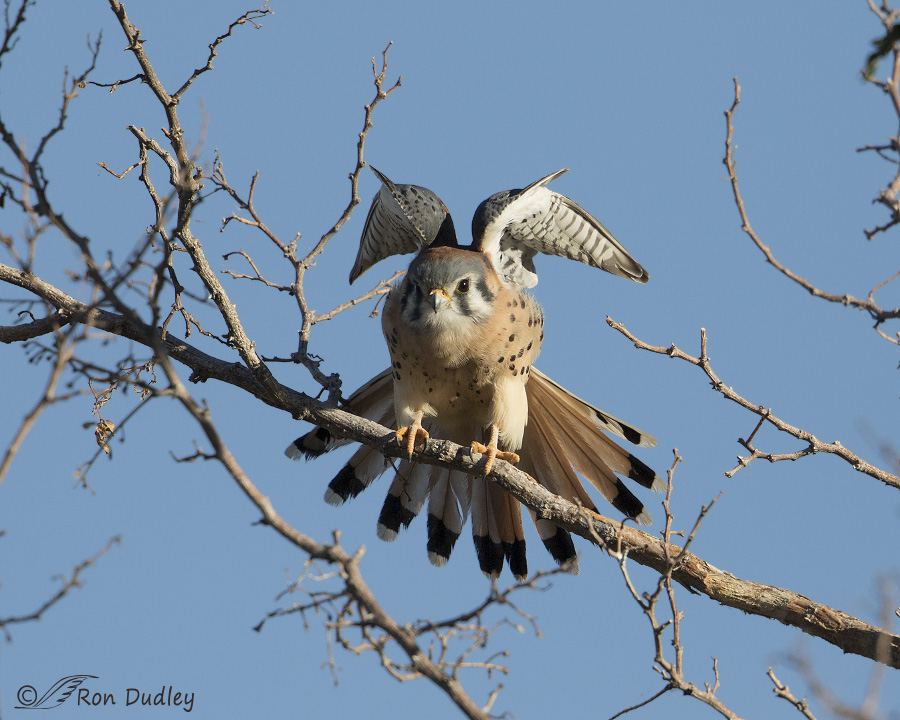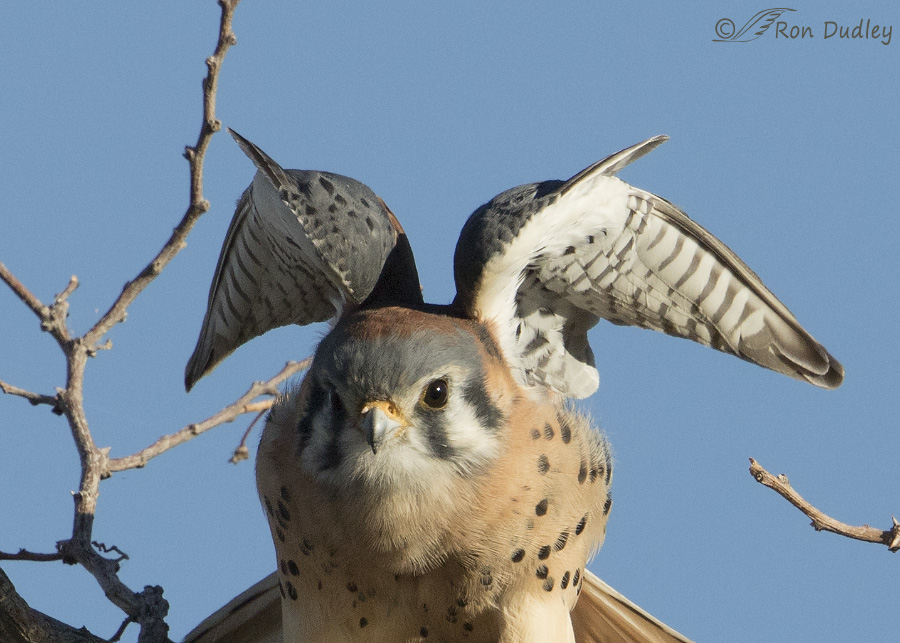Recently I photographed a male American Kestrel in the middle of a wing-stretch and that pose really put his alulae on display. First, for those unfamiliar with the alula I include a description and summary of their function, below (largely taken from a previous post I made on the subject).
- The alula (plural alulae) is the freely moving first digit on the leading edge of the wing of modern birds. In Latin, alula means “winglet”. It is the birds “thumb” and is covered by three to five small flight feathers. The alula is commonly referred to as the “bastard wing” (one of several definitions of the word bastard is “of abnormal shape or irregular size“).
- Normally the alula is held flush along the surface of the wing and is very difficult to see but when landing or flying at very slow speeds (like hovering) the alula moves forward and upward which produces a small slot on the leading edge of the wing and it becomes more visible.
- The function of the alula is similar to that of the slats on the leading edge of the wings of aircraft – to increase the angle of attack of the wing and produce lift, thus helping to prevent a stall during slow flight.
 1/3200, f/6.3, ISO 500, Canon 7D Mark II, Canon EF 500mm f/4L IS II USM + 1.4 tc, not baited, set up or called in
1/3200, f/6.3, ISO 500, Canon 7D Mark II, Canon EF 500mm f/4L IS II USM + 1.4 tc, not baited, set up or called in
As the kestrel stretched he gave me an angle on the alulae that I hadn’t seen before (they’re the pointy projections coming off the top of each wing). Usually they’re held flat against the front of the wing and can’t be easily seen but this pose and angle made them obvious, even while perched.
I’ve done some research on the alulae in the past and apparently there’s some question as to whether or not birds have muscular control over these little winglets or they open and function automatically in response to air flow. Or I suppose it could even be a combination of both.
I keep looking at this image for a clue to the answer to that question but I get conflicting cues. Perhaps one day we’ll know for sure. In the meantime I thought this look at the alulae was an intriguing one.
Ron
Note: For those interested, the alulae open in flight can be seen here.
Addendum: As an afterthought I decided to include a highly cropped version of the previous image to show a little more detail. If you look very carefully you can also see the cone (tubercle) inside the left nostril that falcons are known for.



Great timing. I have never seen a Kestrel stretch like that. Lovely photos!
They don’t do that stretch often, Jean, but I’ve photographed it a few times.
Education and delight.
And gratitude. For the image, the education, and for the fact that my no longer meat eatng self doesn’t have to face the ‘what muscle am I eating dilemma.’
I actually kind of enjoy the intellectual exercise of trying too figure out which muscle it is, EC. Weird, I know…
First biology class – over 50 years ago.
Enjoying learning about biology – still continuing.
Thank you, Ron!
That photograph really shows the beauty of the kestrel!
We must be about the same age, Wally. My first biology class was in 1966. I’m glad you like the kestrel image, thank you.
Hi–please enlighten me about the function of the nasal tubercle that “falcons are known for”–( apologies, I’ll bet most of your subscribers already know, but I’m ignorant of it ! )
No need to apologize, Kris. Please see my answer to the same question asked by David Sorokwasz, below.
Remarkable work on the A. Kestral alulae Ron.
Do you know anything as to the significance of the nasal cone(tubercle)?
David, falcons fly so very fast (especially in a stoop) that the extreme air flow into their lungs through the nostrils would make breathing very difficult. The cone disrupts that airflow and slows it down so breathing can be more efficient.
We had store-fried chicken last night(too tired to cook ) and i noticed the tiny stubs of the alulae on the wings…it felt good to recognize something I’d never even noticed much before I started watching your, Mia and Jerry’s blogs. I can never get over what cute efficient little killers these beautiful little birds are!…
You crack me up, Patty. That’s exactly the kind of thing I notice when I eat meat of any kind. I guess I just spent too much time dissecting vertebrate specimens over the years. I often identify the actual muscle when I’m eating it. Probably not very appetizing for some but it doesn’t bother me…
So glad I’m not the only one who does that! It was an especially prevalent behavior after I took dissection anatomy (human), but has, probably fortunately, decreased over the years. But there are some things that just can’t be helped. It’s good to apply our education…
It’s a difficult habit to break, Susan…
😇
That might be one of the formative reasons I stopped eating meat at a younger age — too much information. :). I even remember my mom comparing the look of raw chicken skin to human skin. Those impressions tend to stay with you.
Spectacular shots and absolutely fascinating information Ron! Thanks so much for sharing!
Charlotte
Thank you, Charlotte.
This is another one of those optical illusion photos for me. It looks to me like he’s got very small, stunted wings compared to the size of his body and tail. It’s a wonderful view of the alulae. Seeing this shot of an American Kestrel makes me miss the ones who hung around here for a couple of years. It makes my day to see a photo of my favorite bird.
I see what you mean about the illusion, Susan. If we didn’t have kestrels around here I’d miss them too. A lot!
OMG – I love all our wonderful birds in Nature & SO appreciate the knowledge you provide about them, Ron!! Thanks for the photos and increased knowledge today of this beautiful little Kestral!!
Thank you, Jo Ann.
REALLY good photo showing the alulae – also went to the linked photo of them open. The biology lesson is always appreciated.:) They almost look like a horn of some sort for stabbing something.
Yes, at this angle they do look sharp and potentially menacing, Nancy.
Way cool Ron! thanks for the information!
I’m glad you found it useful, Nancy. Thanks.